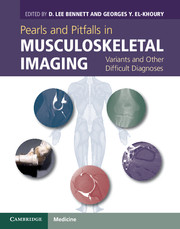Book contents
- Frontmatter
- Contents
- List of contributors
- Foreword
- Preface
- Section 1 Shoulder
- Section 2 Arm
- Case 16 Supracondylar process: ligament of Struthers
- Case 17 Ball-thrower’s fracture: not a pathological fracture
- Case 18 Cortical irregularities of the proximal humerus: pseudotumor humeri
- Section 3 Elbow
- Section 4 Forearm
- Section 5 Wrist
- Section 6 Hand
- Section 7 Hip and Pelvis
- Section 8 Thigh
- Section 9 Leg
- Section 10 Ankle
- Section 11 Foot
- Section 12 Tumors/Miscellaneous
- Index
- References
Case 18 - Cortical irregularities of the proximal humerus: pseudotumor humeri
from Section 2 - Arm
Published online by Cambridge University Press: 05 July 2013
- Frontmatter
- Contents
- List of contributors
- Foreword
- Preface
- Section 1 Shoulder
- Section 2 Arm
- Case 16 Supracondylar process: ligament of Struthers
- Case 17 Ball-thrower’s fracture: not a pathological fracture
- Case 18 Cortical irregularities of the proximal humerus: pseudotumor humeri
- Section 3 Elbow
- Section 4 Forearm
- Section 5 Wrist
- Section 6 Hand
- Section 7 Hip and Pelvis
- Section 8 Thigh
- Section 9 Leg
- Section 10 Ankle
- Section 11 Foot
- Section 12 Tumors/Miscellaneous
- Index
- References
Summary
Imaging description
The radiographs may show focal cortical irregularities in the proximal humerus at various tendon insertion sites. Cortical thickening and lucency may be seen at the deltoid tuberosity (pseudotumor deltoideus) (Figure 18.1). Cortical irregularity may be seen at the anterolateral aspect of the proximal humerus corresponding to the pectoralis major tendon insertion site among gymnasts (ringman's shoulder lesion) (Figure 18.2). Similar radiographic findings may be seen in the proximal humerus anteromedially at the insertion site of the latissimus dorsi and teres major muscles. MR imaging shows signal changes in the corresponding cortex, tendon, and adjacent soft tissue and bone marrow.
Importance
Most of these cortical changes are explained by chronic or subacute avulsive injuries based on clinical history, imaging studies, and follow-up. When symptomatic, because of aggressive radiographic features, a malignant neoplastic lesion may be suspected and the focus may present as a pseudotumor.
Typical clinical scenario
Focal cortical irregularities of the proximal humerus may be asymptomatic, but may become a clinical issue when incidentally found. Symptomatic lesions affect both young and old patients, who usually present with chronic or subacute shoulder pain of insidious onset. History of vigorous exercise may be found in cases of chronic avulsive injuries in young patients. Physical examination may show tenderness to palpation and limited range of motion because of pain. The conditions may be confused with aggressive lesions such as infection and tumor. However, MR imaging is diagnostic for pseudotumor, avoiding biopsy and surgical intervention.
Information
- Type
- Chapter
- Information
- Pearls and Pitfalls in Musculoskeletal ImagingVariants and Other Difficult Diagnoses, pp. 34 - 36Publisher: Cambridge University PressPrint publication year: 2013
References
Accessibility standard: Unknown
- 1
- Cited by
